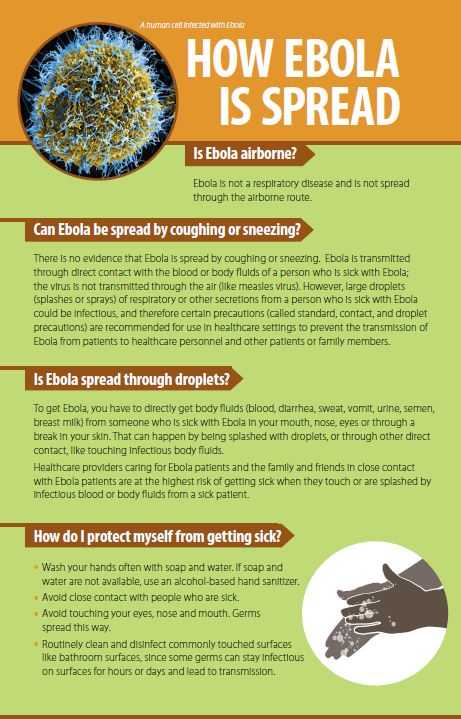Transmission
Because the natural reservoir host of Ebola viruses has not yet been identified, the way in which the virus first appears in a human at the start of an outbreak is unknown. However, scientists believe that the first patient becomes infected through contact with an infected animal, such as a fruit bat or primate (apes and monkeys), which is called a spillover event. Person-to-person transmission follows and can lead to large numbers of affected people. In some past Ebola outbreaks, primates were also affected by Ebola and multiple spillover events occurred when people touched or ate infected primates.
When an infection occurs in humans, the virus can be spread to others through direct contact (through broken skin or mucous membranes in, for example, the eyes, nose, or mouth) with
- blood or body fluids (including but not limited to urine, saliva, sweat, feces, vomit, breast milk, and semen) of a person who is sick with or has died from Ebola,
- objects (like needles and syringes) that have been contaminated with body fluids from a person who is sick with Ebola or the body of a person who has died from Ebola,
- infected fruit bats or primates (apes and monkeys), and
- possibly from contact with semen from a man who has recovered from Ebola (for example, by having oral, vaginal, or anal sex)
Ebola is not spread through the air, by water, or in general, by food. However, in Africa, Ebola may be spread as a result of handling bushmeat (wild animals hunted for food) and contact with infected bats. There is no evidence that mosquitoes or other insects can transmit Ebola virus. Only a few species of mammals (e.g., humans, bats, monkeys, and apes) have shown the ability to become infected with and spread Ebola virus.
Healthcare providers caring for Ebola patients and family and friends in close contact with Ebola patients are at the highest risk of getting sick because they may come in contact with infected blood or body fluids.
During outbreaks of Ebola, the disease can spread quickly within healthcare settings (such as a clinic or hospital). Exposure to Ebola can occur in healthcare settings where hospital staff are not wearing appropriate personal protective equipment.
Dedicated medical equipment (preferably disposable, when possible) should be used by healthcare personnel providing patient care. Proper cleaning and disposal of instruments, such as needles and syringes, also are important. If instruments are not disposable, they must be sterilized before being used again. Without adequate sterilization of instruments, virus transmission can continue and amplify an outbreak.
Ebola virus has been found in the semen of some men who have recovered from Ebola. It is possible that Ebola could be spread through sex or other contact with semen. It is not known how long Ebola might be found in the semen of male Ebola survivors. The time it takes for Ebola to leave the semen is different for each man. Based on the results from limited studies conducted to date, it appears that the amount of virus decreases over time and eventually leaves the semen. Until more information is known, avoid contact with semen from a man who has had Ebola. It is not known if Ebola can be spread through sex or other contact with vaginal fluids from a woman who has had Ebola.
CDC and other public health partners are continuing to study Ebola transmission and will share what is known as it becomes available.
Related Links
- Ebola Survivors
- Why Ebola is Not Likely to Become Airborne [PDF – 1 page]
- Review of Human-to-Human Transmission of Ebola Virus
- Questions and Answers about Ebola and Pets
- Questions and Answers on the 2014 West Africa Ebola Outbreak
- Ebola Virus Disease Information for Clinicians in U.S. Healthcare Settings
- Q&As on Transmission
- Filoviridae
- Page last reviewed: July 22, 2015
- Page last updated: July 22, 2015
- Content source:




 ShareCompartir
ShareCompartir
